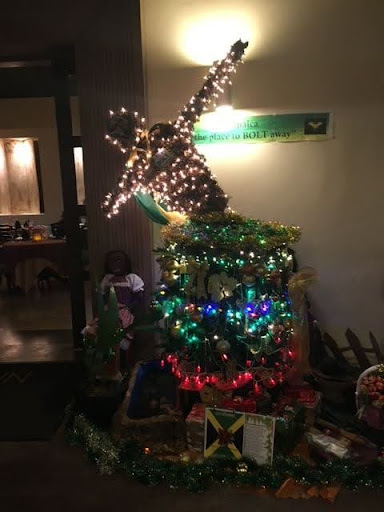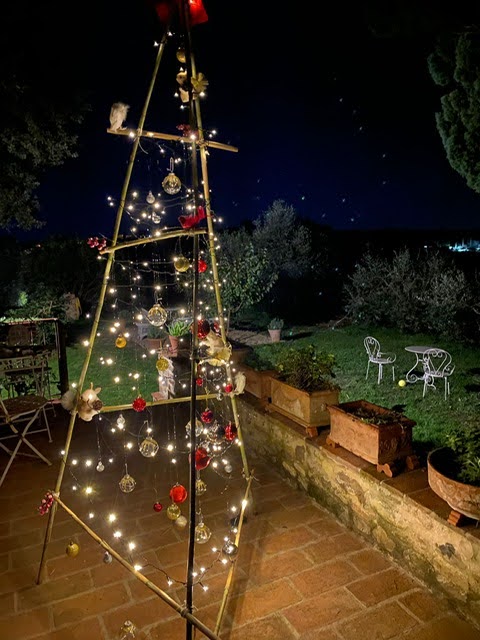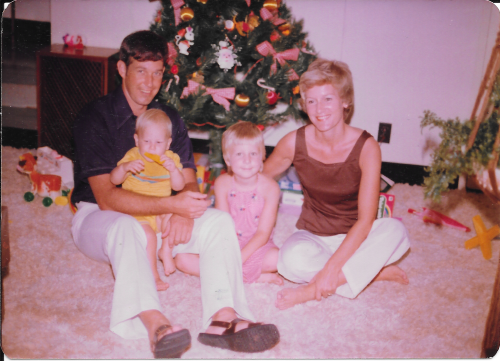Environment Team members share their experiences
The time for carols, holiday baking and other vestiges of traditional holiday cheer is quickly approaching. Amongst the festivities these days comes an increased awareness of climate change and our impact upon it as consumers. An organic conversation regarding Christmas trees popped up during a recent Environment Team meeting. We asked ourselves: Is it "better" for the environment to purchase an artificial tree to reuse over multiple years or to purchase a live tree? What motivates us to lean in either direction? What role do family traditions play in our decision? What are some of the arguments to support either view? This led to the exchange of experiences we would like to share with you this month.
Sheila Doucet, AAWE Paris When we lived in India, it was understandably “difficult” to find a traditional Douglas Fir tree, so we improvised using a tree-shaped IKEA candle holder as a centerpiece set upon an upcycled red and green square cut from a gorgeous old sari. Regardless of the decorations, we thoroughly enjoyed celebrating the holidays with local friends!
 Valerie Garforth, FAUSA Bringing home the Christmas tree is a long-standing tradition with our daughter and her family in California since their children were very young. First thing on the Friday after Thanksgiving Day, they all pile into the car and drive to the local Christmas tree farm. This is a popular time in the community and families line up at the farm gates at 9 am. This is a family business, and the farm grows a large variety of fir trees that they nurture for several years before a certain number of the trees are ready to be cut for the holiday season. There are tractor-drawn sleigh rides through the trees and other child- friendly activities. There is a well-stocked Christmas shop, and the farm provides complimentary cider and popcorn. Once families have chosen their tree, which can take some time as the trees are inspected from all angles and every family member has an opinion as to the right one, the tree is taken to a wrapping station and prepared so that it can be strapped to the top of the car. These are very fresh trees, with a wonderful scent, and can last for many weeks if they are kept in a cool location and the base kept moist with water. Where our daughter lives, the trees are placed on the street after the holiday season and are chipped/shredded and composted or made into mulch, which can be sold back to the community.
Valerie Garforth, FAUSA Bringing home the Christmas tree is a long-standing tradition with our daughter and her family in California since their children were very young. First thing on the Friday after Thanksgiving Day, they all pile into the car and drive to the local Christmas tree farm. This is a popular time in the community and families line up at the farm gates at 9 am. This is a family business, and the farm grows a large variety of fir trees that they nurture for several years before a certain number of the trees are ready to be cut for the holiday season. There are tractor-drawn sleigh rides through the trees and other child- friendly activities. There is a well-stocked Christmas shop, and the farm provides complimentary cider and popcorn. Once families have chosen their tree, which can take some time as the trees are inspected from all angles and every family member has an opinion as to the right one, the tree is taken to a wrapping station and prepared so that it can be strapped to the top of the car. These are very fresh trees, with a wonderful scent, and can last for many weeks if they are kept in a cool location and the base kept moist with water. Where our daughter lives, the trees are placed on the street after the holiday season and are chipped/shredded and composted or made into mulch, which can be sold back to the community.
My husband and I, on the other hand, have a trusty fake tree we bought several decades ago, and it comes out of its box every holiday season. It is just the right height for our living room and fits nicely into the bay window space. The lights shine out onto the street, bringing cheer to the neighborhood. We have exactly the right number of decorations for the tree and several tree skirts that we alternate. Each year the tree has slightly fewer “needles,” but it will surely last us for decades to come (photo).
 Amanda Drollinger, AWC Scotland Christmas trees can be anything, made of anything that you choose to decorate and celebrate, and are proud of. Why not make it an accomplishment or celebration of a success?
Amanda Drollinger, AWC Scotland Christmas trees can be anything, made of anything that you choose to decorate and celebrate, and are proud of. Why not make it an accomplishment or celebration of a success?
For instance, I found this tree in the shape of Usain Bolt in Jamaica. I was there for my youngest brother’s wedding. They wanted a holiday destination wedding in the Caribbean and chose Jamaica. There was no snow. Instead it was warm and sunny. Many of the Christmas trees used found objects sculpted into something new, beautiful and festive. They all were celebrating Jamaica and its people.
I loved this option for how to celebrate at Christmas. The pride in the Bolt continues (photo).
Ann Marie, AWC Finland In Finland, people typically buy a tree from the nearest market square or cut one down and bring it back from their summer cabin. When I first came to Finland, I was used to the full, bushy spruce trees from the upstate New York tree farms and was surprised by the expensive “Charlie Brown” trees being sold here. We didn’t have our own summer cabin where we could go and chop down a tree for our holiday, so I was happy to find a nice artificial tree at the local store that first year. It was my first time ever having an artificial tree, but we’ve now used one ever since. It is nice to have a decorated tree to light up the house for an extended time during the darkest days of the year. We take it down on January 6, Epiphany, which is the traditional day here to take decorations down. The real trees they sell don’t look so scraggly anymore, and we’ve thought about switching, but the lack of maintenance of an artificial tree is great and once we’ve got one, we feel we have to use it to make it worth it.
Joan Niemi Evers, AWC Amsterdam When I was a very young child we had live Christmas trees. However I have no memories of them. Many of the childhood memories I do have are of my cat, Fluffy, who I got when I was six. Her arrival caused our family Christmas tree to become a fake one: Fluffy thought the live tree was a toy – not something to put toys under. That was a bit of a problem! I have a clear memory of the year I wrapped catnip and put it under the tree. She opened it immediately, and well before Christmas Day!
I continued using another fake tree when I started to live on my own. This tree was purchased for my grandmother for the first Christmas after my grandfather passed away. My parents said she had to have a tree that year. That tree was also put in my childhood home’s front window. Fluffy liked to knock it over. I still use it despite it being permanently crooked. It makes me think of who did it.
When I got married we bought live Christmas trees in California, in Amsterdam (where we even brought them to be burned at Museumplein!), and our first year in Madrid. We found it harder to find a live tree in Spain, and instead found our current tree at a home supply store. Our 12-year-old son found his tree at the same store. Our 9-year-old daughter inherited her tree from friends who were moving and didn’t want the tree to come with them.
Now we have a family of trees that we enjoy putting together just after Thanksgiving. One year all the trees were put up in the same room. That ended up making our home look a lot like a department store’s Christmas tree section. I’m sure it gave Santa quite a challenge when it was time to put presents under the tree(s).
Jocelyn Fitzgerald, AILO Florence A Christmas Tree Story: Every year AILO holds a mega Christmas Bazaar. This year the Bazaar Committee and Booth Chairs had a lively and heated discussion on the type of Christmas tree we wanted to use to decorate our lovely venue – a huge greenhouse in the Horticultural Gardens. We were evenly divided when it came to live trees, and the artificial trees we usually use are tired and not very attractive. We needed something creative and worthy of our setting and our image.
We first thought that wooden ladders decorated as trees would be a good solution, but now have come up with the idea of bamboo trees, which fit our ecological profile, are unusual and, actually, very beautiful. Our president, Judi, and many of our members are very artistic. They have already started to make big bamboo trees for the space and small bamboo trees for the tables. I am sure they will be very successful (photo).
 Bamboo tree made and decorated by Judi Roselli-Cecconi, president of AILO.
Bamboo tree made and decorated by Judi Roselli-Cecconi, president of AILO.
 Cristin Middlebrooks, AWC Antwerp In the late 1970s my father was transferred to an army base in Panama. There are three things I remember: frogs as big as shoe boxes, playing in rain-filled holes during the rainy season and having a plastic Christmas tree. I longed for a real tree, just like those I saw on TV. When it was time to return to the States, having a real Christmas tree was what I looked forward to the most and have ever since.
Cristin Middlebrooks, AWC Antwerp In the late 1970s my father was transferred to an army base in Panama. There are three things I remember: frogs as big as shoe boxes, playing in rain-filled holes during the rainy season and having a plastic Christmas tree. I longed for a real tree, just like those I saw on TV. When it was time to return to the States, having a real Christmas tree was what I looked forward to the most and have ever since.
For me, it’s just not Christmas without a live tree. I know it’s silly to spend so much for something that will die in a few short weeks, and I admit that each tree we bring home also includes a hefty side of guilt. However, once the decorations are up, I curl up on the couch with a cup of tea, a good book, the faint smell of pine coming from the tree beside me, and for one all-too-brief moment the bevy of troubles that plague the world disappear. In the twinkling lights of our tree, everything is perfect (photo).
Did any of these anecdotes resonate with you? Our beliefs, decisions and actions are typically guided by a mixture of cultural norms, family traditions, good intentions and circumstances – all of which evolve over time. This is the magic of human behavior, even for something as "simple" as our decisions pertaining to a Christmas tree. As our societies are placed before the realities of an evolving climate, let us continue to humbly integrate new inputs and new perspectives concerning the impact of choices we make.
Resources for further information should our discussion stimulate your interest to learn more:
Real vs. Fake – Which Christmas Tree Is Better for the Environment?

